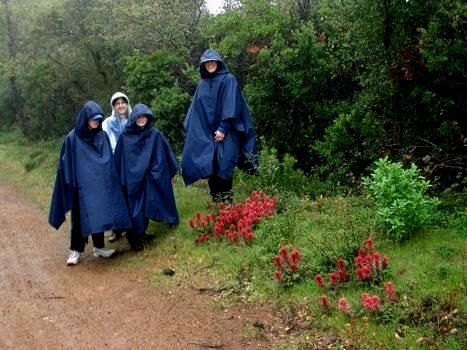
Inclement Weather Garments: Poncho

Figure 1.-- This family has just completed a scouting related hike in the Pacific Northwest. Note that the dad and the two Boy Scouts are wearing matching nylon ponchos. A drawback to nylon ponchos it that wind whips them away from the wearer's legs and sides, leading to wet and cold campers. This isn't a big issue in heavily forested areas, but very annoying in exposed mountainous areas.
|
|
The poncho, a blanket or sheet of water proof material with a hole cut out for the wearer's head. Its origins appear to be the Native American people of the Andes. The Spanish conquest briught the garment tobEurope and North America as the poncho. The Andean people made the Poncho in wool as a garment worn for warmth. The simple square or rectangular shape meant that no sewing or fitting was needed and was thus an easy garment to weave. Done in water proof material, it can be used as rainwear. Modern uses are oprimarilyas rainwear. It is popular wuth campers abd has been used in the military, In both cases it was useful as a garment that could be compactly folded and multiple uses in outdoor situations. A reader writes, "I vividly remember my Boy Scout poncho as being an excellent, multi-purpose garment. It was rubber coated cloth with grommets in each corner, snaps down the sides, and a drawstring closure hood. I used it as rainwear, a shelter, a ground cloth, and backpack cover. " Today, families and older boys tend to wear coated nylon ponchos and younger boys tend to wear single or multi-layer plastic ponchos.
Description
The poncho, a blanket or sheet of water proof material with a hole cut out for the wearer's head.
Origins
Its origins appear to be the Native American people of the Andes. The Spanish conquest briught the garment tobEurope and North America as the poncho. The Andean people made the Poncho in wool as a garment worn for warmth. The simple square or rectangular shape meant that no sewing or fitting was needed and was thus an easy garment to weave.
Purpose
Done in wool, the poncho was a garment worn for warmth, although as it was open at the sides and botttom, it was not very effective at maintaining body warmth. Done in water proof material, it can be used as rainwear. Modern uses are primarily as rainwear, but have a hood added.
Usage
The modern poncho is popular with campers. They are used by American Boy Scouts. Theybhave also been used by the military. In these outdoors cases, the poncho was useful as a garment that could be compactly folded and multiple uses in outdoor situations. A reader writes, "I vividly remember my Boy Scout poncho as being an excellent, multi-purpose garment. It was rubber coated cloth with grommets in each corner, snaps down the sides, and a drawstring closure hood. I used it as rainwear, a shelter, a ground cloth, and backpack cover."
Modern poncho-like garments are still a widely used type of rainwear around the world. They are basically a poncho, but with a hood afdded. The rubber/vinyl coated cloth poncho is still in use with military organizations. They are durable and hold up with rough wear. The coated nylon and plastic ponchos are the most widely used by modern boys. Families and older boys tend to wear coated nylon ponchos and younger boys tend to wear single or multi-layer plastic ponchos. Some or rather flimsy garments, but are light weight and can be folded up in a very compact for. Americans call them ponchos. The British call them anoracks, a term also used for a heavy parka. We notice Cubs and Scouts with anoracks as they can be so easily carried. The weather in Britain can be quite variable. It can be sunny and then rainy and sunny again on the samne day. So the light-weight anoracks are very useful for outings by youth groups.
HBC

Navigate related Boys' Historical Clothing Web Site weather pages pages:
[Return to the Main rainwear page]
[Return to the Main inclement-weather Clothes page]
[Coats]
[Knits]
[Leggings]
[Ponchos]
[Sweaters]
[Underwear]
[Other cold-weather wear]
Navigate the Boys' Historical Clothing Web Site:
[Introduction]
[Activities]
[Biographies]
[Chronology]
[Cloth and textiles]
[Clothing styles]
[Countries]
[Topics]
[Bibliographies]
[Contributions]
[FAQs]
[Glossaries]
[Images]
[Links]
[Registration]
[Tools]
[Boys' Clothing Home]
Created: 7:12 AM 1/1/2011
Last updated: 7:12 AM 1/1/2011



